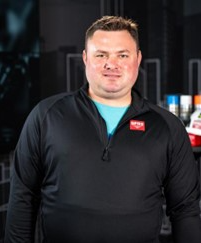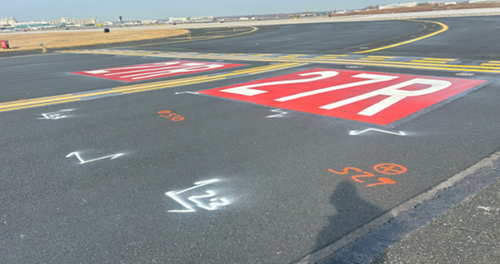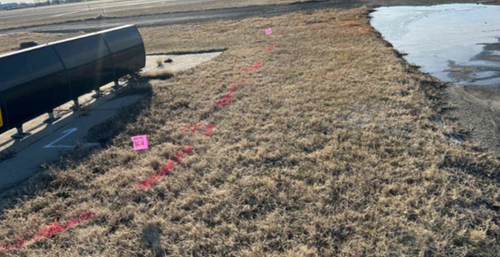GPRS Ensures Safe Execution of 128 Soil Borings at Philadelphia International Airport
The airport’s nonstop operations required performing scans in high-traffic taxiway zones and introduced logistical challenges.

GPRS Project Manager Andrew Heine
Provided important data for a general contractor without impeding busy international airport operations.
Although the term "boring" appears in soil borings, GPRS Project Manager Andrew Heine’s work at Philadelphia International Airport was anything but monotonous. Tasked with supporting a large-scale, time-sensitive project for James J. Anderson Construction, Heine played a critical role in ensuring safe, efficient drilling operations across multiple taxiways.
The project required 128 soil borings to assess environmental conditions by testing for contaminants in the subsurface. These assessments were integral to a planned restoration initiative aimed at rehabilitating aging taxiways.
“They'll bring those soil borings back to the lab and test them for contamination, but they really want to redo some of these taxiways because they're getting old,” Heine explained. “So, it's like the groundwork for this future project.”
Given the airport’s nonstop operations, performing scans in high-traffic taxiway zones introduced logistical challenges. GPRS needed to work quickly and precisely while ensuring uninterrupted airport function.

GPRS scanned a 10x10 ft. area around each proposed soil boring location under the tarmac so that general contractor James J. Anderson Construction could safely complete 128 cores.
Navigating Operational Constraints
Heine’s team collaborated closely with airport escorts to comply with strict operational protocols. Managing these restrictions required adaptability and strategic planning to ensure scanning efforts aligned with flight operations.
“We had escorts making sure we weren't in the way of any planes, and they're real strict about that for good reason,” Heine noted. “So that was part of the challenge since we could work some of the time. A lot of times we had to get out of the way, but we were able to make it happen.”
Despite tight scheduling requirements, the project was executed ahead of time. With assistance from GPRS Project Manager Trainee Carlos Hernandez, the scanning process was streamlined, allowing for an efficient, smooth operation. Their ability to navigate operational restrictions while maintaining precision demonstrated the value of GPRS’ expertise in subsurface investigations.
“This [job] took six and a half days, and we finished it early,” Heine said. “Actually, I had a trainee with me who made it go a lot more quickly. We were ahead of schedule, and it was a pretty smooth operation.”

GPRS flags and markings alongside the airport taxiway, delineating a utility line.
Preventing Utility Strikes Through Advanced Locating Technology
The designated boring locations were marked with orange flags and spray paint, and Heine’s team scanned each site, identifying and mapping underground utilities to mitigate risks.
“While we were there, the customer marked out their borings in orange. Then we scanned it and made sure they wouldn’t hit anything within a 10-foot radius,” Heine explained.
During the scanning process, Heine discovered critical underground infrastructure directly beneath some planned boring sites. Identifying these hazards was vital in preventing potential service disruptions, worker injuries, and costly damage.
“That’s a [power] line, and that’s pretty much right on [the core location]. So, I think if we weren’t there, they would have hit that line for sure. If they just did it anyway [without GPRS], they would have hit a few things,” he said.
By leveraging GPRS’ industry-leading 99.8% accuracy in utility scanning, potential strikes were avoided, ensuring safe drilling while preventing costly disruptions or hazardous incidents. Without proper subsurface investigations, accidental strikes could have led to power outages, delays in airport operations, or compromised worker safety.
Every underground utility and concrete structure identified by GPRS was documented using SiteMap® (patent pending), providing the client with a detailed and accessible record of on-site infrastructure. This data was crucial for ensuring informed decision-making and minimizing risk during future project phases.
Best Practices for Safe Soil Borings
Soil borings play a key role in Phase II Environmental Site Assessments (ESAs), providing insights into subsurface conditions. However, drilling without proper utility locating presents significant risks. Hiring experienced professionals ensures these risks are mitigated and that environmental data collected is both accurate and reliable.
To maximize project safety and efficiency, best practices include:
- Scheduling utility locating services before drilling commences to ensure subsurface risks are identified before equipment is deployed
- Adhering to established ground disturbance policies to prevent unexpected conflicts and ensure compliance with regulations
- Utilizing SIM-certified professionals, such as those at GPRS, who verify findings through multiple scanning technologies
- Maintaining clear records of all findings to assist with project planning and future subsurface assessments
GPRS remains committed to its pursuit of 100% subsurface damage prevention. With its cutting-edge SiteMap® technology and unparalleled accuracy, GPRS Intelligently Visualizes The Built World® to empower contractors to drill confidently, maintain schedules, and protect personnel. By prioritizing proper subsurface investigation techniques, construction teams can safeguard critical infrastructure while optimizing project success.
What can we help you visualize?
